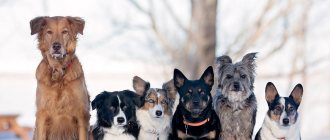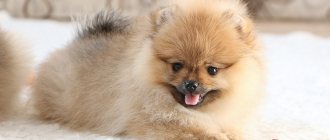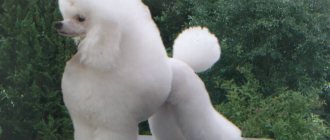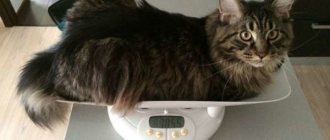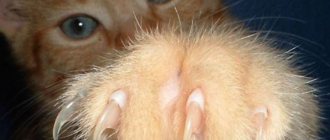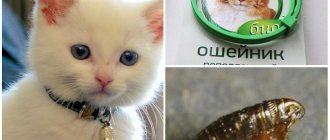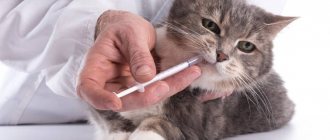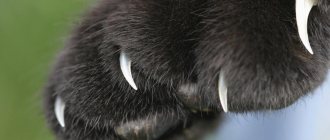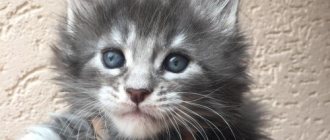The Toy Terrier has long been one of the most popular breeds in Europe. And Russia is no exception in this regard. Which is understandable - cheerful, cute, compact, these dogs make you fall in love at first sight. But before you bring a toy terrier into your home, it is useful to study the breed standard. This is especially important for people planning to exhibit their pet at exhibitions or use it for breeding and obtaining elite puppies.
Elegant and sophisticated
General characteristics of the breed
Each dog breed is unique. Moreover, they differ not only in appearance - weight and dimensions, but also in character, attitude towards people, tendency to train and other important features.
You should definitely know about them - then several months after the pet appeared in the house, you won’t have to be disappointed in a bad choice.
Fact! The Toy Terrier (aka Russian Toy) was bred in the USSR in the mid-twentieth century - the basis was the English Toy Terrier.
Character and temperament
One of the most important parameters of a toy terrier is character. Overall, he is perfect for becoming a true friend for the whole family. A faithful one will accompany the owners during walks, play with pleasure with children, lie quietly and think about his own life in the company of older people.
At the same time, although the toy terrier’s height is not very impressive, the dog simply does not know fear. If necessary, he will rush at any enemy, even if he is several times larger, and will not retreat, protecting his master.
By temperament, this is a real choleric person. He simply cannot sit still for even one extra minute - he needs to constantly run somewhere, climb, explore. At the same time, he gets along well with other pets, especially if they were adopted before the arrival of the tiny dog and do not demonstrate excessive aggression. So, there probably won’t be any problems with a standard toy terrier.
Important proportions
Despite the fact that the size of the Toy Terrier dog is not very impressive, it looks literally square and because of this it is strong. And all because of the special ratio - at the elbow its height is almost half the height at the withers. The chest is strong and quite deep, which additionally creates the impression of power, although this does not fit well with a miniature dog.
Puppy weight and height by month
The table is indicative. A discrepancy of ±300-400 g is possible. It is worth examining the dog if the weight differs from the table by 1 kg.
Puppies grow disproportionately: in one month they gain a lot, and in the next month the weight will not change . Focus on the condition of the toy. If he is active, playful and eats well, then everything is fine.
The conventional concept of norm also applies to growth.
Puppies are sold at approximately 3 months . At this moment their height is 15-20 centimeters.
The standard toy will grow even bigger by 6-9 months, but the mini toy will no longer be there.
Weight table:
| Age | Toy terrier weight at birth, g | ||||||||
| 70 | 80 | 90 | 100 | 120 | 130 | 145 | 160 | 170 | |
| 1 Week | 110 | 115 | 145 | 160 | 185 | 230 | 255 | 270 | 285 |
| 2 weeks | 145 | 160 | 185 | 200 | 255 | 315 | 355 | 390 | 415 |
| 3 weeks | 170 | 200 | 230 | 255 | 315 | 400 | 455 | 500 | 550 |
| 1 month | 200 | 230 | 270 | 320 | 370 | 485 | 540 | 595 | 650 |
| 2 months | 315 | 370 | 455 | 550 | 610 | 765 | 830 | 940 | 1050 |
| 3 months | 460 | 570 | 690 | 795 | 910 | 1135 | 1250 | 1390 | 1525 |
| 4 months | 600 | 750 | 880 | 1020 | 1165 | 1450 | 1620 | 1760 | 1900 |
| 5 months | 710 | 880 | 1025 | 1190 | 1365 | 1705 | 1875 | 2045 | 2200 |
| 6 months | 765 | 970 | 1150 | 1295 | 1510 | 1900 | 2100 | 2280 | 2500 |
| >1.5 years | 1000 | 1200 | 1400 | 1700 | 1900 | 2300 | 2500 | 2800 | 3000 |
Growth chart:
| Month | Height, cm |
| 1 | 6-10 |
| 2 | 10-14 |
| 3 | 14-20 |
| 4 | 18-24 |
| 5 | 20-28 |
| 6 | 20-28 |
| 6-9 | Formation is over |
Breed standard and what purebred dogs look like
There are fairly strict standards for each breed. They regulate every part of the body - at first glance they are not striking, but a real expert will instantly evaluate the dog and easily identify any shortcomings and deviations. That is why it is important to know what standards are set for the Russian Toy.
Head
The head is given special attention.
Compared to the body, it is quite compact - dry, light. When viewed from above, the wedge-shaped shape catches the eye. The occipital protuberance protrudes weakly. At the same time, the skull is not very wide, but high. The forehead is slightly rounded - this feature is well defined, but not too noticeable.
The transition of the forehead to the muzzle is well defined and has an average depth.
It is very important to pay attention to the jaws. The bite should be scissor bite. In some cases, a direct bite is acceptable - with it two or three pairs of incisors are in contact. However, it is undesirable.
The eyes are large, expressive, round. Set wide and straight. In most cases, brown - the shade may vary, but the darkest is desirable. Eyelids - the color of the main color or dark.
The ears are quite large, thin, and set high. They definitely stand and are shaped like an isosceles triangle. For long-haired toys, slightly floppy ears are acceptable.
Important! Short-haired Toys do not tolerate low temperatures and wind. Therefore, they should definitely buy clothes for the winter, as well as light boots or thick socks so that they can walk comfortably.
Frame
There are two varieties.
The body is tightly built, but at the same time compact. The top line gradually decreases - from the very withers to the beginning of the tail. The withers themselves are not too pronounced, and the back is straight and strong. The latter smoothly transitions into a short, slightly convex and very muscular lower back. The croup is not too wide, moderately long. It has a slope - compared to the horizon line, about 15 degrees.
The chest in cross section resembles a slightly flattened oval. It reaches right up to the elbows.
The stomach is tucked, the groin area is tucked. The bottom edge is gracefully curved.
Forelegs
When viewed from the front, the limbs are parallel.
- The shoulder blades have a moderate slope and are of average length.
- The length of the shoulders is almost equal to the length of the shoulder blades.
- The articulation angle is about 100-110 degrees.
- Elbows point only back.
- Wrists are dry.
- The forearms are straight and long.
- The paws on the limbs are small, oval.
- The pads are elastic, black.
Hind limbs
Looking from behind, you can see that the limbs are parallel and straight. Slightly wider than the front ones. The thighs are moderately long, with developed, dry muscles. The length of the lower leg is approximately equal to the length of the thighs. The hock joints have a moderate angulation.
Leather
The skin is quite thin and fits tightly to the body.
Movements
When walking, the dog demonstrates light, moderately sweeping, energetic movements. During the trot, the top line of the back remains level - the withers only rise slightly. When a dog walks, it holds its head proudly and carries its tail high.
Jury members at exhibitions always pay attention to these indicators and highly appreciate the exact compliance with the standards.
Interesting! Although the breed was developed in the mid-20th century, it was officially recognized by the Fédération Cynologique Internationale only in 2021—almost ten years after the American Kennel Club.
Height and weight standard
1 month
By the end of the first 30 days of life, the baby should weigh from 200 to 650 g. It all depends on the size of the toy. If the puppy’s body weight exceeds the norm by 150 g, there is no need to worry and put the growing “child” on a diet.
2 month
At two months of age, puppies should increase their body weight to 1050 g - this is the maximum. The minimum weight of a healthy dog is 320 g.
3 month
After another 30 days, the dog becomes heavier by another half kilogram if he has the upper mass indicators; and 140 grams, if lower. At this age, the weight of a toy terrier, according to the table, cannot be less than 460 and more than 1550 g.
4 month
At 4 months, babies weighing 600 g are considered quite healthy and well-fed, and large representatives of the breed can have a body weight of 1.9 kg.
5 month
Already at 5 months, the toy’s weight indicators are approaching the maximum mark, although the dog will still grow and develop for at least a year. So, five-month-old terriers can weigh from 700 g to 2.2 kg.
6 month
A six-month-old toy can already have the weight of an adult dog, which ranges from 800 g to 2.5 kg. But don't panic if your toy terrier's measurements differ from those in the table. Not all dogs of this breed grow up to 1.5 years; the growth of some stops already at the age of five months, and accordingly the dog will not gain much weight. Therefore, to clearly answer the question “Until what age does the Russian Toy Terrier grow?” difficult.
Observe your baby's behavior. A pet should be cheerful, cheerful and very active. If all of this applies to your pet, but its dimensions are different from those indicated in this article, do not worry, everything is fine with it.
Standard sizes
If we talk about the standards provided for each breed, then we should definitely mention such important indicators as weight and dimensions. There should definitely be no deviations here - even a slight departure from the established limits can be a reason for the dog to be disqualified. Therefore, these parameters are very important to know.
Weight, height of boys and girls
The puppies are simply adorable
Before talking about how much a toy terrier weighs, it is worth immediately noting that this breed, like all other dogs, has larger males than females. In general, the weight of a toy terrier ranges from 2 to 3 kg. It is very important to monitor this parameter carefully.
Unfortunately, many breeders cannot resist the charm of their pet and often feed it excessively. And this, combined with low activity, quite often leads to excess weight gain and even obesity. So, if a breeder wants his pet to take part in exhibitions and be healthy, he should definitely know how much a toy terrier should weigh and make sure that the dog does not go beyond these limits.
Also, if we talk about the toy terrier, it is worth giving the size of an adult dog. Typically, males have a height at the withers of about 24-28 cm, and females - around 22-26. Yes, they are quite compact - many other breeds have puppies that are noticeably larger than the adult animals here.
Excess weight: causes and treatment
When a Toy Terrier becomes overweight, the stress on fragile bones increases . The risk of heart and liver diseases increases. The risk of diabetes increases.
Examine the dog yourself. While standing, feel the sides and back of the animal. If the ribs and spine are weak or cannot be felt at all, then the toy is overweight.
Constipation, excessive sweating and shortness of breath also indicate excess weight..
Causes of obesity:
- Poor nutrition. Overeating is unacceptable. Toys may not feel the measure. Limit access to food, introduce 2 meals a day.
- Sedentary lifestyle. Even if the dog goes to the tray or on a diaper, arrange walks in the air.
- Malfunctions of the body.
What to do:
- Consult your veterinarian. If a disease is detected, he will prescribe a course of treatment.
- Stick to your diet. Do not feed toy from the table, reduce the portion size. Change the food to something special for overweight dogs.
- Increase your physical activity. Play with your dog, buy toys. Go for walks regularly. If you have a lot of excess weight, start gradually. At first, just walk 30 minutes a day. When the dog becomes easier, introduce running and games.
NOTE!
The required caloric intake for a dog can be calculated using an online calculator.
You will need to enter the dog’s parameters, activity level and find out the number. The calorie content of one serving is usually indicated on the package; if eating natural foods, calculate the number of calories manually, for example, using a mobile application and scales.
Meeting height and weight standards is required to participate in shows . If you don’t plan to visit them, then don’t exhaust your dog in pursuit of the ideal. The most important thing for a toy terrier is the care of the owner.
Follow the basic rules - meals 2 times a day, no handouts from the table, physical activity and regular monitoring by a veterinarian.
Read more detailed information about caring for a toy terrier here.
Useful video
From the video you will learn everything about the Toy Terrier dog breed:
The question of how old a toy terrier grows worries owners of miniature breed puppies. Since the period of growth and formation of a pet is accompanied by many problems. Experienced dog lovers, knowing full well how old a terrier grows, support the dog’s body as much as possible during this period.
Feeding
Despite the fact that the Russian Toy Terrier is a miniature dog and does not need large portions of food, its diet must still contain all the necessary nutrients and minerals.
Adult dogs
Feeding rules:
- main meals: twice a day - in the morning and after an evening walk;
- It is allowed to pamper your pet with a treat in the middle of the day (dog biscuit, leather bone);
- calculation of the daily diet: 50–80 grams of food per 1 kg of animal weight;
- when calculating daily feeding, the dog’s lifestyle is taken into account: older and inactive people require less food than young and active people or pregnant women;
- food should be at room temperature;
- The water is certainly raw, but filtered.
Daily diet:
- meat: lamb, veal, raw beef;
- poultry: boiled turkey and chicken (boneless);
- sea fish - boiled fillet;
- porridge: oatmeal, buckwheat, rice (with water);
- fermented milk products: low-fat cottage cheese, kefir, fermented baked milk;
- vegetables (carrots are required) - fresh (grated on a fine grater), stewed, boiled (without salt);
- fruits: bananas and apples are especially useful.
Weekly (no more than once):
Boiled eggs;
- offal: heart, kidneys, liver;
- corn porridge.
Contraindicated products:
- milk;
- sausage (any);
- smoked products;
- pork;
- nuts;
- legumes;
- sweets;
- bell pepper
If you prefer to feed your pet dry food, you will find the necessary instructions for this on the package. There is no universal guide for dry food, since different manufacturers have different compositions of nutrients included in them.
High-end ready-made food is produced by: Hills, Royal Canin, Orijen, Canidae, Eagle Pack. Please note that these companies produce food specifically for small dogs, some even by breed, as indicated on the packaging.
Puppies
Naturally, from the moment they are born, babies are fed exclusively with mother's milk. After three weeks, without removing the mother from the breast, small complementary foods are introduced. Additional food in the form of beef and low-fat cottage cheese is given in small peas - always warmed to room temperature - 3 times a day.
Menu from 6 to 8 weeks (feeding every 4 hours):
- 1 feeding: a ball of raw meat;
- 2 feeding: cottage cheese diluted with milk or kefir;
- 3 feeding: cottage cheese again;
- 4 feeding: porridge boiled in water - rice, oatmeal or buckwheat;
- 5 feeding: milk porridge;
- 6 feeding: a pea of raw meat.
It is best for puppies to eat meat from the menu listed above, however, you should not exceed the recommended daily portion. There is a significant risk that she will continue to prefer only meat. Ignoring other foods will have a bad effect on his health and overall well-being.
The diet from two to five months remains the same, supplemented with vegetables and fruits. Meals are reduced to four times a day.
From five months, the feeding schedule is adjusted to three meals a day, and after nine months - to two meals a day, with the transition to the diet of adults.
It is extremely important to ensure that the baby receives the food it needs in full. Otherwise, this is fraught with improper development of the musculoskeletal system. This can be tracked quite simply: the puppy must be periodically felt - the ribs should not be noticeable, but they should be felt. If you deviate from this condition, you need to adjust the power supply, depending on which direction the slope goes.

